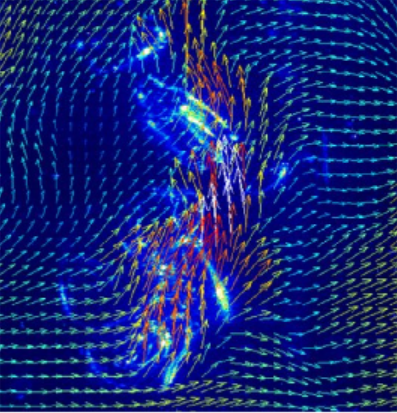Module 9: Vectors (Chapter 9)
Section outline
-
 A vector is a mathematical tool that
indicates both a direction and a size, or magnitude. Vectors are often
represented visually as arrows. Usually the magnitude of the vector, (the
wind speed in this example), is shown by the length of the arrow, but
sometimes a color key makes the map easier to read.Of particular interest are the winds produced by tropical storms, or hurricanes and the forces that create the storm. Near the Earth's surface, winds spiral towards the center of a hurricane. They rotate in a counterclockwise direction in the Northern Hemisphere and in a clockwise direction in the Southern Hemisphere. These rotating winds are called the hurricane's primary circulation.A hurricane's primary circulation involves four main forces:
A vector is a mathematical tool that
indicates both a direction and a size, or magnitude. Vectors are often
represented visually as arrows. Usually the magnitude of the vector, (the
wind speed in this example), is shown by the length of the arrow, but
sometimes a color key makes the map easier to read.Of particular interest are the winds produced by tropical storms, or hurricanes and the forces that create the storm. Near the Earth's surface, winds spiral towards the center of a hurricane. They rotate in a counterclockwise direction in the Northern Hemisphere and in a clockwise direction in the Southern Hemisphere. These rotating winds are called the hurricane's primary circulation.A hurricane's primary circulation involves four main forces:-
the pressure gradient force,
-
the Coriolis force,
-
the centrifugal force, and
-
friction.
The center, or eye, of a hurricane contains the lowest atmospheric pressure, so the pressure gradient pulls air towards the center of the hurricane. In the Northern Hemisphere, this air is deflected towards the right because of the Coriolis force, a result of the Earth's own rotation. As the air turns to the right, the primary circulation around a hurricane begins to develop. Hurricane researchers know that strong vertical wind shear is a major factor affecting potential hurricane development. Wind shear is the variation of the wind's speed or direction over a short distance within the atmosphere. If there is too much wind, a storm has trouble developing into a cyclone. With little or no wind shear, the turning within the tropical system becomes vertically aligned, helping to keep it intact. Thus, the most favorable condition for tropical cyclone development is the absence of wind shear.Using simple mathematical models, researchers can estimate the degree to which the center of the storm becomes vertically tilted, based on the cloudiness within the eyewall and the structure of the wind outside the eyewall. By modeling the development of storm tilt, a better understanding of a tropical cyclone's behavior is gained in the presence and absence of wind shear. In particular, an El Niño weather system creates changes in the jet stream over the Northern Hemisphere, resultingin decreased wind shear in the Pacific and increased wind shear across much of the Atlantic basin, which suppresses hurricane activity. These model simulations show promise in understanding the processes driving the intensity of tropical cyclones.Image Caption: We can use vectors to indicate the speed and direction of the wind.
(Content & Image Source: Chapter 9 Introduction, Trigonometry, Katherine Yoshiwara, GNU Free Documentation License)
Upon completion of this module, you will be able to:9.1 Geometric Form-
Sketch a vector
-
Identify equal vectors
-
Sketch a scalar multiple of a vector
-
Sketch the sum of two vectors
-
Calculate a resultant vector
-
Use vectors to solve problems
-
Find components of a vector
-
Find the magnitude and direction of a vector given in components
-
Subtract vectors
9.2 Coordinate Form-
Convert the coordinate form of a vector to geometric form
-
Convert the geometric form of a vector to coordinate form
-
Compute sums and scalar multiples of vectors
-
Find a vector in a given direction with a given length
-
Solve problems with vectors
9.3 The Dot ProductTo achieve these objectives:- Find the component of
 in the direction of
in the direction of 
-
Compute the dot product
-
Find the angle between two vectors
-
Resolve a vector into components in given directions
- Read the Module 9 Introduction (see above).
- Read Sections 9.1-9.3 of Chapter 9: Vectors in Trigonometry (links to each Section provided below)
- Note: The Algebra Refresher at the top of each Section might be beneficial before you begin
- At the end of each Section there is a list of Vocabulary, Concepts, Study Questions, and a Self-Check H5P activity
- Complete the MyOpenMath Homework Assignments for each Section (links provided below) - These are graded!
- View the Chapter 9 Summary and Review (link provided below)
- Practice the problems on the Exercises Sections, checking the solutions provided (links to each Section provided below)
- View the Exercises: Chapter 9 Review Problems (link provided below)
- Complete the MyOpenMath Quiz for Chapter 9 (link provided below) - This is graded!
- Once you complete the Quiz, upload your work in the Quiz Work Upload Assignment using the submission link below.
- Post in the Chapter 9 Q&A Discussion Forum - link provided below.
Note the check boxes to the right that help you track your progress: some are automatic, and some are manual.
Module Pressbooks Resources and Activities
You will find the following resources and activities in this module at the Pressbooks website. Click on the links below to access or complete each item.
-
Background Colour
Font Face
Font Kerning
Font Size
Image Visibility
Letter Spacing
Line Height
Link Highlight
Text Colour
